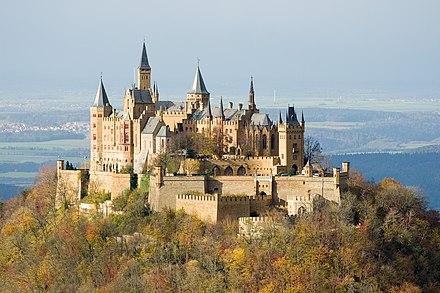Wikipedia:WikiProject Germany/Portal:Baden-Württemberg
Introduction

Baden-Württemberg (/ˌbɑːdən ˈvɜːrtəmbɜːrɡ/ BAH-dən VURT-əm-burg, German: [ˌbaːdn̩ ˈvʏʁtəmbɛʁk] ⓘ), commonly shortened to BW or BaWü, is a German state (Land) in Southwest Germany, east of the Rhine, which forms the southern part of Germany's western border with France. With more than 11.07 million inhabitants across a total area of nearly 35,752 km2 (13,804 sq mi), it is the third-largest German state by both area (behind Bavaria and Lower Saxony) and population (behind North Rhine-Westphalia and Bavaria). As a federated state, Baden-Württemberg is a partly-sovereign parliamentary republic. The largest city in Baden-Württemberg is the state capital of Stuttgart, followed by Mannheim and Karlsruhe. Other major cities are Freiburg im Breisgau, Heidelberg, Heilbronn, Pforzheim, Reutlingen, Tübingen, and Ulm.
What is now Baden-Württemberg was formerly the historical territories of Baden, Prussian Hohenzollern, and Württemberg. Baden-Württemberg became a state of West Germany in April 1952 through the merger of South Baden, Württemberg-Baden, and Württemberg-Hohenzollern. These three states had been artificially created by the Allies after World War II out of the existing traditional states by their separation over different occupation zones.
Baden-Württemberg is especially known for its strong economy with various industries like car manufacturing, electrical engineering, mechanical engineering, the service sector, and more. It has the third-highest gross regional product (GRP) in Germany. Part of the Four Motors for Europe and located in the Blue Banana, some of the largest German companies are headquartered in Baden-Württemberg, including Mercedes-Benz Group, Schwarz Group, Porsche, Bosch and SAP.
The sobriquet Ländle, a diminutive of the word Land in the local Swabian, Alemannic and Franconian dialects, is sometimes used as a synonym for Baden-Württemberg. (Full article...)
Selected article

The Blautopf (German for Blue Pot; "blau" means blue, "topf" means pot) is a spring that serves as the source of the river Blau in the karst landscape on the Swabian Jura's southern edge, in Southern Germany. It is located in the city of Blaubeuren, approximately 16 km (9.9 mi) west of Ulm. It forms the drain for the Blau cave system and feeds the river Blau, which after 14.5 km (9.0 mi), flows into the river Danube in the city of Ulm. Because of its high water pressure, the spring has developed a funnel-like shape, which at its deepest point has a depth of 21 metres (69 ft). The water's peculiarly blue color, varying in intensity due to weather and flow, is the result of chemical properties of limestone densely distributed in the water.
Numerous legends and folk tales refer to the Blautopf. Its characteristic colour was explained by the account that every day someone would pour a vat of ink into the Blautopf. Another myth stated that every time someone tried to measure the Blautopf's depth with a leaden sounding line, a water nix stole the sounding line. Therefore, it was not possible to determine the depth of the Blautopf. Because of this tale, there is a rock called Klötzle Blei ("little block of lead" in the local dialect) in the vicinity of the Blautopf.
Selected biography

Hildegard Knef (28 December 1925 – 1 February 2002) was a German actress, singer, and writer. She was billed in some English language films as Hildegard Neff or Hildegarde Neff. Hildegard Knef was born in Ulm. Her parents were Hans Theodor and Friede Augustine Knef. Her father, who was a decorated First World War veteran, died of syphilis when she was only six months. Then her mother moved to Berlin and worked in a factory. Knef began studying acting at the age of 14, in 1940. She left school at 15 to become an apprentice animator with Universum Film AG. After she had a successful screen test, she went to the State Film School at Babelsberg, Berlin, where she studied acting, ballet and elocution. Josef Goebbels, who was Hitler's propaganda minister, wrote to her and asked to meet her, but Knef's friends wanted her to stay away from him.
State facts
- Nickname: Ländle
- Capital: Stuttgart
- Minister-president: Winfried Kretschmann
- Governing parties: Greens / CDU
- Total area: 35,751 km2 (13,804 sq mi)
- Population: 10,879,618 (2015)
- Founded: April 25, 1952
- Website: www.baden-wuerttemberg.de
Selected image
Did you know?

- ...that the Wilhelma in Stuttgart is Europe's only large combined zoological and botanical garden, and is home to over 8,000 animals representing more than 1,000 different species, as well as more than 5,000 species of plants..
- ...that Albert Einstein was born in the Kingdom of Württemberg? Einstein is best known in popular culture for his mass–energy equivalence formula E = mc2. He received the 1921 Nobel Prize in Physics for his "services to theoretical physics".
Subcategories
Selected panorama
.jpg/440px-Unteruhldingen_Pfahlbaumuseum_(02-2).jpg) |
Pfahlbaumuseum Unteruhldingen (German for 'Stilt house museum') is an archaeological open-air museum on Lake Constance (Bodensee) in Unteruhldingen, Germany, consisting of reconstructions of stilt houses or lake dwellings from the Neolithic Stone Age and Bronze Age.
Topics
Related portals
Associated Wikimedia
The following Wikimedia Foundation sister projects provide more on this subject:
-
Commons
Free media repository -
Wikibooks
Free textbooks and manuals -
Wikidata
Free knowledge base -
Wikinews
Free-content news -
Wikiquote
Collection of quotations -
Wikisource
Free-content library -
Wikiversity
Free learning tools -
Wikivoyage
Free travel guide -
Wiktionary
Dictionary and thesaurus






